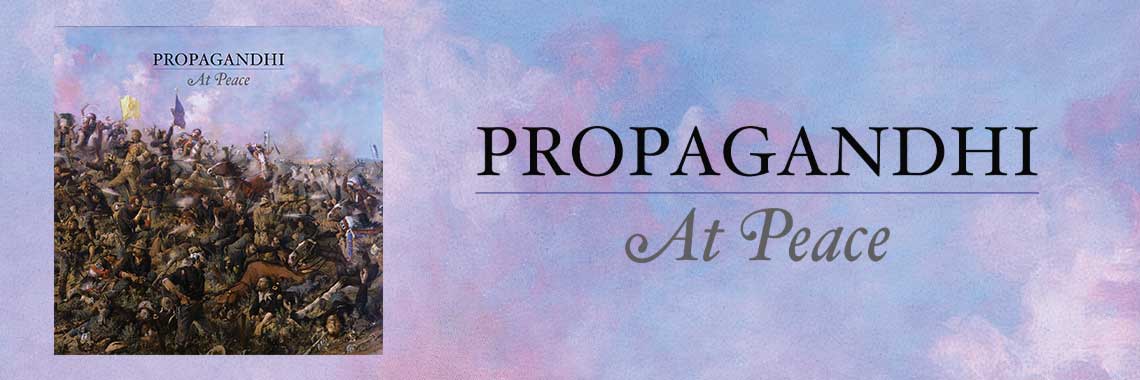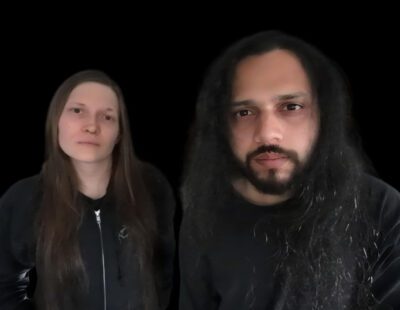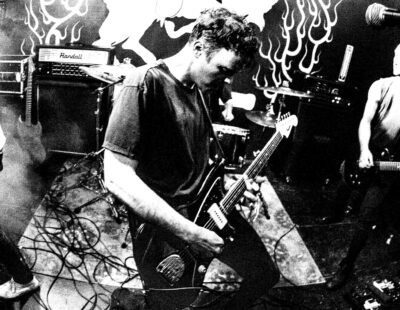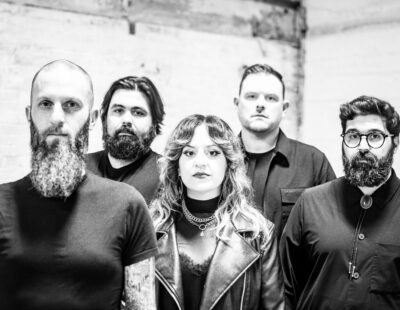
Finnish weirdos Hukuts self-describe their sound as “transmutating extreme soundscapes” and, despite initial reservations about what that could possibly mean, that’s the best descriptor I could come up with too. Their new album Oksitosiini–Finnish for “oxytocin,” a naturally-occurring hormone–goes many places, with the only consistent being the eerie atmosphere throughout.
Band members Aoghori and Opakj provided Decibel with an exclusive stream and a track-by-track for Oksitosiini. Listen and read on below.
AVE MARIANA:
Aoghori:
As far as the tempo and lyrics go, the first three songs form a continuum of sorts. “Ave Mariana” deals with my perversion of the isa-rune. The line drawn with ice, the primal waters and paralyzed focus are married to the idea of an extreme sensory deprivation. Basically this song is about dying, a physical death and the death of your ego. Water is a feminine element and Mariana is a female name. Several songs on the album deal with giving names; I like the idea of validating something with a name.
Opakaj:
Every track is built upon a specific musical idea or wrapped around some musical kink. The foundation of Ave Mariana rests on an attempt to create a musical unity into the eye of something exceptionally heavy and cacophonous. The beginning has a defiant discord to it, then the bouncy rhythm and an out-of-tune piano driven through a guitar amplifier ooze a sneering and a vile tone to the song. The latter half of the track acts as a counterbalance to the doomy beginning with it’s yearning beauty.
NADIIRIT:
Aoghori:
And now, Mariana has many names. The keyword in “Nadiirit” is fear and fear comes in all kinds of different forms. It’s a tool that can be used to dominate and it also forms a sort of an initiation rite. As a huge horror fan, I think about experiencing fear quite a lot. You can be seeking thrills, processing taboo subjects or you can just be having a bad trip in the wrong place.
Opakaj:
The idea of ”Nadiirit” plays around dissonant octave chords. It all comes down to it, whether it is used to build tension or to reduce it. Behind that, the main pulse of the song is a caveman-esque pounding, that was layered with distorted hammonds and noise. The song is easy to play and we made it like that on purpose.
KOITUS:
Aoghori:
It’s a sonic assault towards the cosmos. Lyrically this is about black hierogamy, having violent sex with your own Satan. It is named Kabuki Salmakis, meaning the hermaphrodite master of disguise. I’m drawn to the idea of having a dark alter ego, like Norman Bates’ “Mother”, the doppelgangers of Twin Peaks and the jungian shadow.
Opakaj:
The basis was to create a song that would be fast, hectic, gripping and the pace would be stop and go. And that’s exactly what the song is. The real challenge was to make a monotonous base feel layered, so that the song would grow and hold your interest. It was seasoned with frenetic, cosmic synth-bleeping and tremolo picking/guitar melodies alternating between major and minor scales. The end result came out rather original.
SE SEISOO:
Aoghori:
The most spritual song on the album. In addition to the obvious sexual metaphor (the title roughly translates to “It’s erect/ It stands”), it’s an exaltation that was inspired by my thoughts of runes and pentagrams resembling the postures and shapes of the human body. We are channeling forces by making gestures, as body language affects everything. Do you stand in line like a sheep or do you stand your ground?
Opakaj:
”Se seisoo” is the most hypnotic track on the album. The droning discords grow and transform. Then it all erupts into a harmonic melancholy, only to fall back into the pandemonium. The word “seisoa” (Finnish for “standing”) fits the midsection and the latter part of the song. You stand in line, you sway around – looping in a trance. The track is a combination of psychedelia, hopelessness and groove.
TAPA ITSE:
Aoghori:
In Finnish mythology, Itse is a crucial part of the soul that can be lost if one does things that are considered detrimental or spineless. I have deliberately left it open for interpretation whether the lyrics are about someone consciously killing Itse. Besides that, it’s self-explanatory – face your shadow. Chasing an abstract soma, the monumental drug or a paradise. There is also the idea of paradise as a forest, that can be the garden of Eden, the Aokigahara suicide haven or a ghetto concrete jungle.
Opakaj:
”Tapa Itse” is the first song that was written for Hukutus. It’s similar to the feeling when you first get your driver’s licence and get behind the wheel. The song runs amok, from one part to the other, but with a purpose. It’s a mixture of old scraps and novelties; there’s a definite raw punk influence here. The goal was to create an opening riff that would also work in the end, slowed down to a crawl. And it works like a charm.
METSÄ JA YÖ:
Aoghori:
In contrast to the previous song, we are now facing the dark woods as a sacred place. You are alone in a forest at night. Knowing that you are small, but also a part of a greater whole. You feel your roots growing.
Opakaj:
This is by far the most ambitious composition on the album. There are red herrings for the listener, a very droney vibe, the heaviest parts on the whole album and a long, melodic, tremolo picking midsection. Pure wanking from the songwriter’s point of view.
ABSTRA-KA-DABRA:
Aoghori:
I have pondered what would happen if all the beliefs and ideologies in this world would be true and they would manifest in the flesh of a single entity. The lyrics are written from the point of view of this entity. The militant drumming is meant to symbolize the tirade of this absolute and the song title itself is a reference to the shambling and bullshit we face each and every day.
Opakaj:
The main influences here were tribal percussions and classical music. The long chord progression after the chorus was a passage that we were obsessed with and we just had to insert it to some song. I’ve always enjoyed the way you bring a long progression “back home” like that, after twists and turns. It’s quite brash and contains an unusual major scale ending. I’d say the song itself is a bit unorthodox.
JOKAINEN HAUTAA OMANSA:
Aoghori:
The title is a direct quote from Pet Sematary, ”each buries his own”. I wanted to capture the bleak, but mysterious feel of that story. The lyrics are kinda all over the place; they juxtapose the shamanistic trance and transformation to the idea of life as a whole and a dance of death. We go through multiple dead-ends, insanities and metamorphoses and in the end each one buries their own.
Opakaj:
It was clear early on that this would be the ending track on the album, so maybe it pushed the composition into a more epic direction. Here we have elements dating back to 2011 and stuff from 2016. Hukutus’ songs contain lots of chromatic scales, but on this song the experimentation is taken to the extreme. The end time feeling is omnipresent.







